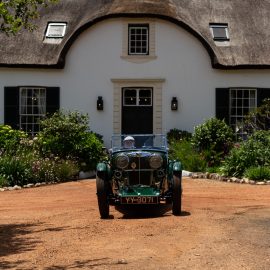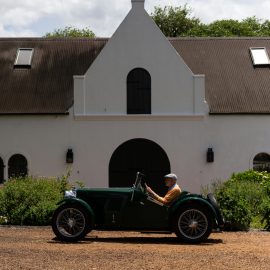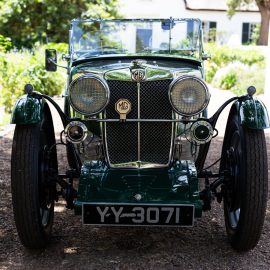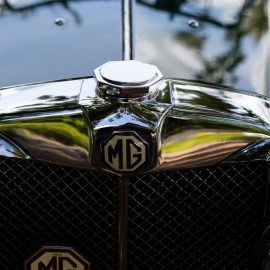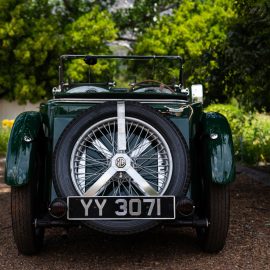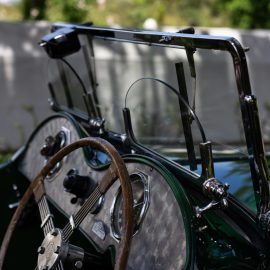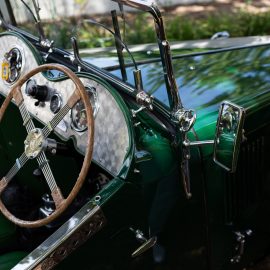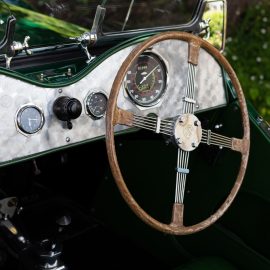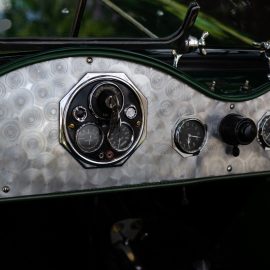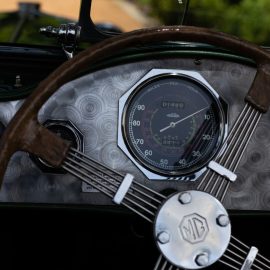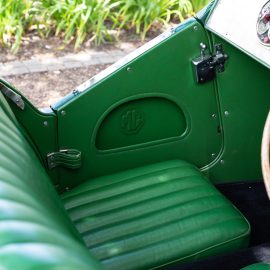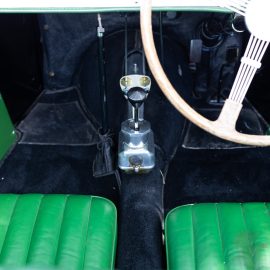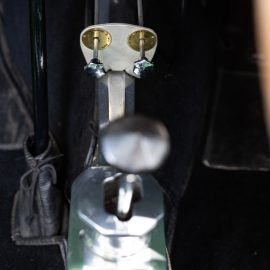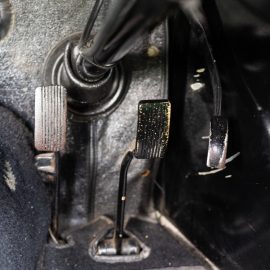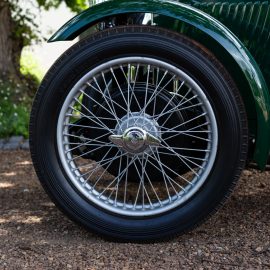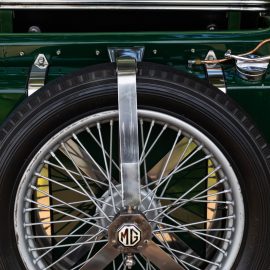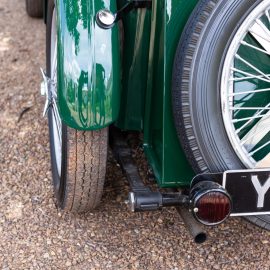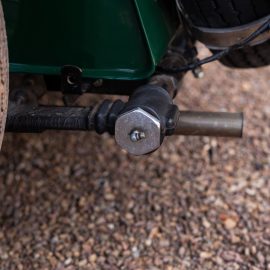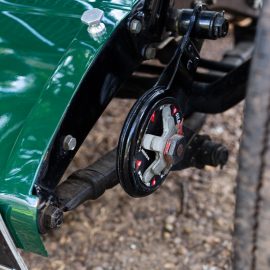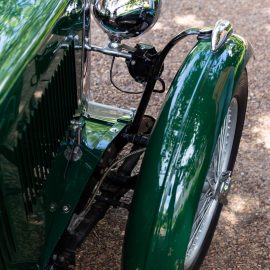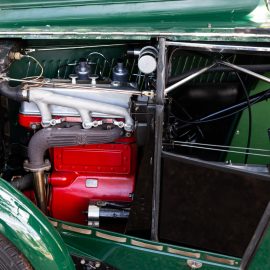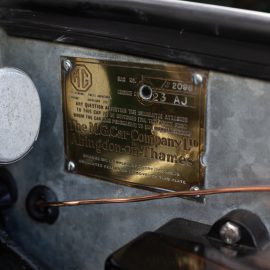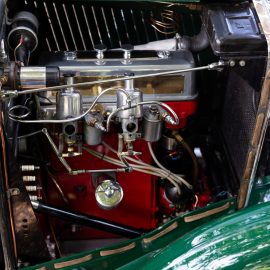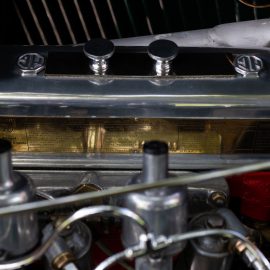
13 Dec Anniversary Celebration: 1932 MG Midget J2
A regular feature covering vehicles in the FMM collection that are celebrating an anniversary during 2022. The last one for 2022 is a superb example of a classic British sports car. Mike Monk gives some barefoot impressions…
The J2 Midget is one of a trio of single-overhead-cam-engined MGs collectively known as the Triple M (MMM). The letters stand for the J2 Midget, L Magna and K3 Magnette models that first appeared in the early-1930s. Announced in August 1932, the J2 Midget was outstanding value for just £199-10s-0d and was within the reach of many enthusiasts of the era. It was based on the successful design of the C-Type Montlhéry Midget. The car featured a large, rear-mounted slab-type petrol tank with a ‘fast filler cap’, a fold-flat windscreen with optional aero screens, centre-lock 19-inch Rudge Whitworth wire wheels, remote control gear change, and a spring-spoked flat steering wheel. Protective mesh grilles for the headlamps and radiator were additional cost extras.
The chassis layout incorporated virtually straight side members passing under the rear axle with tubular cross supports. Suspension was by half-elliptic springs all round on sliding trunnions. Retardation was by Bowden cable-operated brakes utilising eight drums. The handbrake was mounted on a shaft linked to the foot pedal and four cables, which allowed easy adjustment. Friction-type Hartford shock absorbers were fitted front and rear, the latter transversely. The chassis was lubricated by a Tecalemit central greasing system. Other features of the chassis included a 12-volt Rotax lighting and starting system.
The J2 was strictly a two-seater and set the fashion in MG sports cars for many years to come. With its classic ‘two humped’ scuttle and low, cutaway doors, the car was a masterpiece of simple, functional race-bred design that MG utilised for decades to come, and is today considered by many to be one of the classic sports cars of all time. The long bonnet conceals not only the engine, but the gearbox, foot controls and driver’s/passenger’s legs! The tail of the car was short and stubby only extended by the 12-gallon (54,5 litres) slab tank, and the strapped-on spare wheel. Initially, the car was produced with cycle-type front and rear wings, which were replaced a year later with long, swept wings.
Power came from the well-tried 847cc engine as used on the successful M-Type, which was derived from a Wolseley unit. With an eight-port crossflow cylinder head and twin SU carburettors, this unit produced a healthy 36 hp (26,8 kW) at 5 500 r/min though with only a two main bearing crankshaft, revving the engine to its maximum soon produced premature failure of the flimsy crankshaft. A vertically-mounted dynamo was driven off the front end of the crankshaft, with its armature forming part of the ohc drive. This particular design was a weak point on these engines with seals leaking oil into the dynamo, causing embarrassing flat batteries.
The four-speed non-synchro gearbox has a neat remote gear change enclosed in an alloy casting, bringing the gear lever very conveniently to the driver’s hand – but driver beware! The shift pattern has 1-2 on the right-hand-side of the H gate, and 3-4 on the left… The top two ratios are close, giving a good high speed range, whilst first and second gears are suitably low for trials work and suchlike. There is a fair step between second and third ratios. A single plate dry clutch transfers the power via a Hardy Spicer propshaft to the three-quarter floating rear axle.
FMM’s 1932 J2 has chassis number J2098, and according to an MMM Register that was compiled in 2000, its original engine number was 2031AJ and was sold to Graham Bostock in the UK. It later came into the hands of a transport executive in Cape Town before being bought at auction by renowned SA classic car enthusiast Bertie Bester around 1990, from whom FMM purchased the car. The car now has engine number 001E900831 but very little is known of the car’s history. However, it is believed the car was never raced and has never been in an accident.
Resplendent in British Racing Green, it is a very impressive-looking vehicle – and so small! For my long-legged,1,9-metre frame, getting in presented something of a challenge, but necessitated taking off my size 9 shoes because the pedals – in particular accelerator and brake – are so close together. I realised that despite spending much of my life involved with cars, I had never driven a pre-war MG, so anticipation was high.
Ignition on, depress the foot-operated starter button mounted high on the scuttle board, and the engine fires up easily. The clutch is light, and remembering the back-to-front gear change, I was soon on my way. Once adjusted to the gap between second and third gear ratios, and double declutching to smooth changes, the J2 offered a really fun driving experience. The cutaway door provided some necessary elbow room as the steering wheel-to-chest gap is minimal. The low, flat seating position and high scuttle heighten the J2’s sporty feel, which by vintage standards provides a relatively comfy ride. Top speed was claimed to be 80 mph (128,7 km/h) but 125 km/h is a more realistic figure. Zero to 50 mph (80,5 km/h) took around 15 seconds. Fuel consumption was 35 mpg (8,1 litres/100 km).
Model-life production of the J2 from mid-1932 to 1934 totalled 2083 units, so this car is relatively rare. It is in superb condition and I thoroughly enjoyed the drive. There is a thriving Triple-M Register that helps preserve these MGs, and long may that continue.
FMM’s 1932 MG Midget J2 is currently on view in Hall C.




